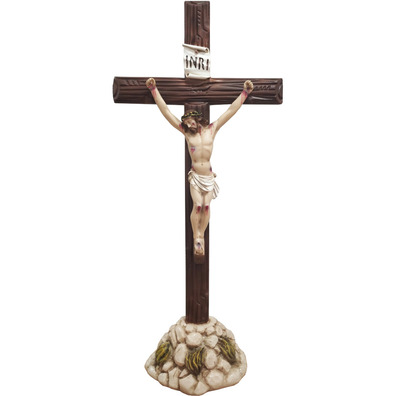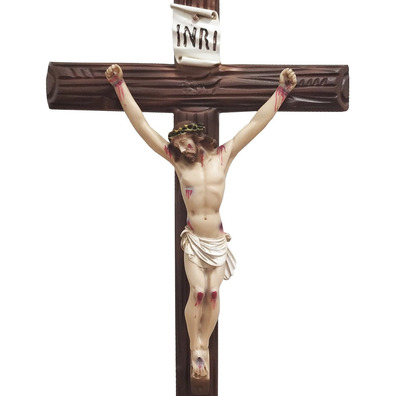Resin Table Crucifix with INRI
75,00€
Taxes includedCatholic product in stock. Products ready to be shipped. You can check the approximate delivery time during the purchase process.
Resin Table Crucifix with INRI
- Crucifix made of polyester resin.
- Total height: 59 cm (23.23 inches).
- Dimensions of the Cross: 50 cm high x 26 cm wide (19.69 inches high x 10.24 inches wide).
- Height of the figure of Christ: 28 cm (11.02 inches).
- Base dimensions: 17 cm wide x 14 cm deep (6.69 inches wide x 5.51 inches deep).
Meaning of Crucifix
Crucifixes, the representations of Christ on the Cross, are a central symbol of Christianity. The term "crucifix" is derived from the Latin words "crucis" (genitive of "crux", meaning "cross") and "fixus" (past participle of "figere", meaning "to fix" or "to nail"). Originally, the crucifix referred to any person nailed to a cross, but over time, the term was limited to the representation of Christ on the Cross.
Crosses and Crucifixes are reminders of the presence of Christ among us and the great sacrifice Jesus made for humanity. The Cross itself symbolizes Christ's victory over sin and death. Originally, the Cross was an instrument of torture and death in antiquity, but for Christians, it has become a symbol of life and hope.
The Cross also represents the union of the divine and the human in the person of Jesus Christ, who, as God and man, bore the sin of humanity and died on the Cross for our salvation.
The body of Christ on the crucifix symbolizes the suffering and death he experienced on the Cross. The wounds on Christ's hands, feet, and side recall his painful passion and death. At the same time, the wounds also represent God's reconciliation with humanity, as through his suffering and death, Christ won the forgiveness of sins for all believers.
What does INRI mean on the Crucifix?
The term INRI is an abbreviation of the Latin phrase "Iesus Nazarenus, Rex Iudaeorum," which translates to "Jesus of Nazareth, King of the Jews." This phrase appears in the four canonical Gospels of the New Testament and refers to the inscription that the Roman soldiers placed over Jesus' Cross during his crucifixion.
The Romans placed this text for several purposes. First, to identify the person crucified and why they were in that situation. In this case, it was Jesus, and his crime was proclaiming himself King of the Jews.
Secondly, the inscription was a mockery and humiliation towards Jesus.
Despite the original objectives with which the Romans used these signs, the word INRI has gone down in history as an important religious symbol for Christians. The word INRI symbolizes Jesus' claim as king and saviour of humanity.
The phrase "Jesus of Nazareth, King of the Jews" also recalls the humility and obedience of Jesus, who accepted God's will and died on the Cross for our salvation.








